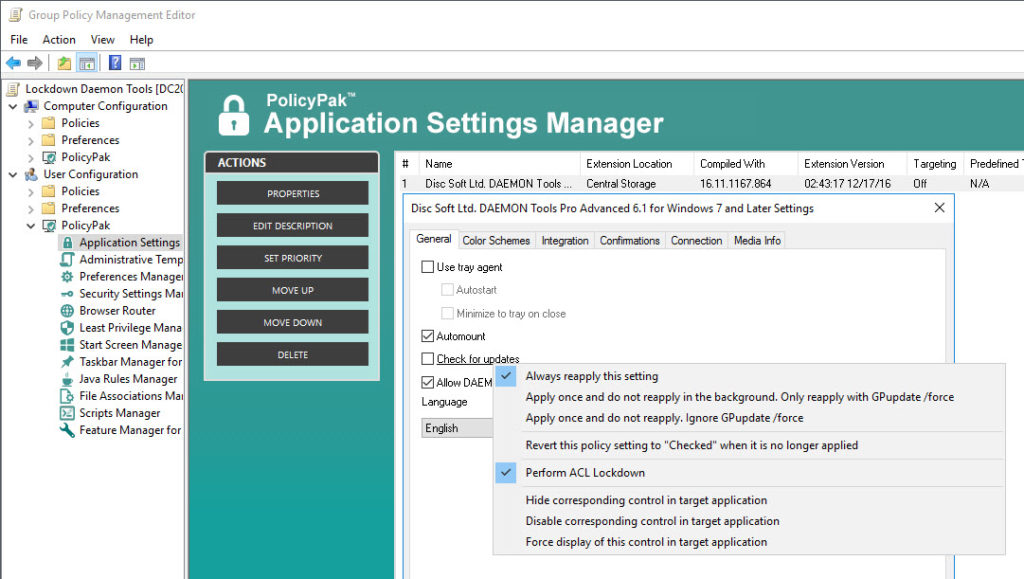Daemon Tools is a scary name, but it isn’t scary at all. It’s DVD/CD Emulator. It makes it easy to work with ISO files. It’s also easy for your users to emulate your configuration settings with their own within this application and mess things up as quickly as Daemon Tools can mount an ISO virtual drive on your computer.
That’s where PolicyPak comes in. We enforce and lock down the optimum settings that you, the administrator, want them to have. PolicyPak sets and enforces expectations for your users’ applications, so that they get the same experience, every time they launch it.
Oh, and PolicyPak also supports Daemon Tools too, just as we do so many other applications.
Keep your Daemon Tools configuration settings enforced and streamlined with PolicyPak. Check out this video to see how it’s done:
With PolicyPak, you’re the one in control.
Besides, once you’re using PolicyPak to manage Daemon Tools, you’ll also get to manage all your other enterprise desktop applications the same way: Flash, Lync, Java, Firefox, and any custom applications you have. They’re 100% included – absolutely free.
It’s all included when you’re a PolicyPak Professional customer.
PolicyPak was designed by Microsoft MVP, Enterprise Mobility Jeremy Moskowitz – who “wrote the book” on Group Policy, runs GPanswers.com, and lives and breathes Group Policy and enterprise software deployments and desktop lockdown.
When you’re ready to get serious about managing Daemon Tools, PolicyPak is ready for you.
Lockdown Daemon Tools with Group Policy video transcript
Hi, this is Jeremy Moskowitz, Microsoft MVP, Enterprise Mobility and Founder of PolicyPak Software. In this video, we’re going to learn how to manage and lockdown Daemon ToolsPro using PolicyPak.
I’ve already got Daemon Tools installed on my computer, and I’m just a regular user here. As you can see, I’m logged on as a guy called “eastsalesuser4.” If we open up this application from the start menu and go to Tools | Preferences we see a number of settings here for us to configure.
I’ll go to “General” where I can control how this application starts and performs updates. “Confirmations” has settings concerning the mounting and unmounting of virtual drives. Finally, in “Connections” I have important proxy and authentication settings that I definitely don’t want my users messing with.
Let’s see how we can ensure compliance and perform desktop management of settings quickly using PolicyPak. I’ll go ahead and switch over to my Management Station computer.
We’ll go ahead and right click over our “East Sales Users”, “Create a GPO” and we’re going to call it “Lockdown Daemon Tools.” So this GPO is now associated with the “East Sales Users.” I’ll right click over it. I’ll click “Edit…” I’ll dive down under “User Configuration,” “PolicyPak/Applications/New/Application.” There it is, “PolicyPak for Daemon Tools Pro Advanced” along with other applications like “Java,” “Flash” “Firefox,” “Skype” and lots of other important desktop applications that your users utilize every day (and you want to make more secure.).
Let’s start with “General” where I want to do something I do for so many applications, make sure that my users don’t involve themselves in updating this application. I’m going to disable “Check for Updates” by making sure this setting always remains unchecked. Notice how the setting became underlined as soon as the checkbox value changed. This means that the setting value is going to be delivered through PolicyPak. Now to make sure that it never becomes checked I am going to right click on it and select “Hide corresponding control in target application” so my users won’t even know the setting even exists.
While I’m on this tab I’ll go and enforce “Automount”.Now to make sure that my users never change this setting I’m going to right click and select “Perform ACL Lockdown.” This is a unique feature that only PolicyPak can deliver. It locks down the setting and prevents the user from altering it, even if they attempt to do so through the registry itself.
Next I’ll go to “Connections” and prevent my users from configuring any Proxy settings. I’ll make sure that “Use proxy server” is unchecked as well as and then I’ll right click on the tab and select “Disable corresponding control in target application.”
Finally, I’ll go to “Confirmations” where I want to uncheck “Remove orphaned images.” Then I’ll hide this setting the same way I did earlier.
Now I will go back to my client machine, we’ll get a command prompt and run “gpupdate.” Now you could envision the user logging on for the very first time, using a Terminal Services or Citrix machine, using a VDI session, changing job roles, or getting a new computer. I just happen to be using gpupdate.
Now that that’s done, let’s go ahead and reopen the application. We can see that our desired settings for “General” have been delivered and even hidden in the case of Updates.Notice that in Connections users cannot modify the Proxy Settings at all. On the Confirmations tab we see that the designated setting is hidden as well. Now let’s pretend that this user is registry savvy and attempts to modify the setting through the registry. I have saved the registry location of this setting and as you can see here, ACL Lockdown even thwarts the best efforts of this user within the registry as well.
And we are done. That is how incredibly easy it is for you to use PolicyPak to manage and lockdown Daemon Tools as well as tons of other desktop applications.
If you’re looking for a trial of PolicyPak, just click on the “Webinar / Download” button on the right.
Thanks so much for watching, and get in touch with us if you’re looking to get started. Talk to you soon.




